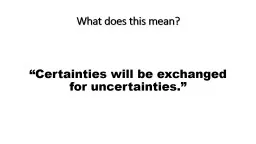

uncertainties Important Concepts Regarding Spread of Christianity Why did missionaries have greater success in Spanish America and in the Philippines The overwhelming European presence conquest settlement missionaries forced labor social disruption disease ID: 797784
Download The PPT/PDF document "What does this mean? “Certainties will..." is the property of its rightful owner. Permission is granted to download and print the materials on this web site for personal, non-commercial use only, and to display it on your personal computer provided you do not modify the materials and that you retain all copyright notices contained in the materials. By downloading content from our website, you accept the terms of this agreement.
Slide1
What does this mean?
“Certainties will be exchanged for
uncertainties.”
Slide2Important Concepts Regarding Spread of Christianity
Why did missionaries have greater success in Spanish America and in the Philippines?
The overwhelming European presence (conquest, settlement, missionaries, forced labor, social disruption, disease)
Seemed as if old gods had been “bested” and future lay with the new powerful religion
Note: These were localized, small-scale, orally based religions (would be less resistant)
Slide3Important Concepts Regarding Spread of Christianity
What made Europeans different than earlier conquerors?
No official flexibility.
“They claimed exclusive religious truth and south the utter destruction of local gods and everything associated with them.”
Why was there very limited acceptance of Christianity in early modern China?
Page 658 - 659
Slide4Persistence and Change in Afro-Asian Cultural Traditions
Syncretic religions develop:
Vodou
(
Vodun
) in Haiti
Santeria in Cuba
What are they a combination of?
West African traditions and Catholicism
Slide5Slide6Reminders of Earlier Spread of Islam
Southeast Asia & West Africa Islam was introduced by traveling merchants and solidified by activities of Sufi Holy men UNLIKE Middle East, India, and North Africa where is was established by
Arab and Turkish Conquest
Ottoman,
Safavid
, and Mughal empires had
Turkik
origins, while the Songhay Empire did not
The Ottoman and
Safavid
ruled over heartland of Muslim world, where majority of subjects followed Islam. The Mughal and Songhay ruled over regions were Islam was a minority faith.
The rulers of the
Safavid
Empire were the only ones to impose a Shia version of Islam as the official religion of the state
Slide7Further Spread of Islam
Anyone else confused by page 660?
Main ideas:
The islands of Southeast Asia illustrate the diversity of belief and practice that accompanied the spread of Islam in the early modern era
Aceh vs.
Java
Accommodation vs. more orthodox version of the religion?
Religious syncretism became increasingly offensive and heretical
religious renewal and reform that emerged in 18
th
century
Examples:
Aurangzeb (1658-1707)
Religious wars in West Africa
Southeast & Central Asia: tension grew between localized and blended versions of Islam and those who sought to “purify such practices in the name of a more authentic” faith
Slide8Wahhabism
Mid-18
th
century
Arabia
Islamic scholar: Ibn
Abd
al-
Wahhab
Argued weakening of Islamic world was due to deviations from the pure faith of Islam
Considered school of Sunni Islamic thought
Received political backing of Muhamad Ibn Saud
Became an expansive state in central Arabia (Mecca itself under Wahhabi control in 1803)
Slide9Developments in India
Bhakti Movement
Sikhism: 15
th
CENTURY!
Monotheistic religion
First guru = Guru Nanak
Focused on developing love toward humanity and the divine, leading eventually to the end
of reincarnation, value
honest labor and
social
service
Most famous place of worship = Golden Temple in Amritsar
Have no idols
Recognize no caste restrictions
Slide10Sikhismhttps://www.youtube.com/watch?v=RdlPy5HlppY
https://
www.youtube.com/watch?v=vXErPzsqRu8
https://
www.youtube.com/watch?v=5zRko61jDT0
(“It comes from a time, when there was both Hinduism and Islam”)
https://
www.youtube.com/watch?v=c2yYpLQepH4
Slide11Changes in China?
Buddhism?
Kaozheng
?
Neo-Confucianism?